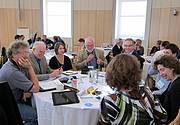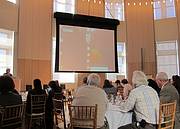Canada National Committee of IUCN Members
01 August 2012 | Article
Canada National Committee of IUCN Members (CCIUICN) was established in 1992 by a small group of governmental and non-governmental members and individuals active in IUCN. Its aim is to assist in the achievement of the IUCN mission: "A just world that values and conserves nature", and serve as a vehicle to consult on conservation policy in Canada and to promote policies consistent with those of IUCN.
In 2009, following the Barcelona Congress, CCIUCN contributed to key IUCN governance issues including the ‘One Program Commitment Statement’ through Council’s online consultation and reform of the Motions Process.
In 2010 the CCIUCN Board focused on improving its communications with Members. It developed a formal communications plan and established an online file-sharing website, then launched it’s first-ever website in 2011. In early 2012 it launched an E-Newsletter which will be distributed to members bi-annually to provide information on recent and upcoming activities. In 2010 the Board also completed important housekeeping tasks, working with a legal adviser to update CCIUCN’s status as a not-for-profit organization and revising the by-laws.
At the global level, Canadian IUCN and Commission members contributed significantly to IUCN achievements including redevelopment of the IUCN Sustainable Use Specialist Group and strengthening of the IUCN Global Protected Areas Program. Canadian WCPA Chair Nik Lopoukhine led a strong representation to CBD COP10 in Nagoya. WCPA was recognized as a principal source of advice on technical subjects in the decisions reached in Nagoya on the Program of Work on Protected Areas.
2011 was an active year as CCIUCN hosted two major meetings. On May 26 nearly 100 participants gathered for a panel discussion on issues in the North, where pressures on resource exploitation are increasing against a background of rapid climate change. Experts from government and non-government groups gave their views on topics including sustainable wildlife use, aboriginal traditional knowledge, sustainable economic development, protected areas and marine transportation. Emphasis was on how groups can work together to ensure that development in the North occurs in a sustainable manner, and the role that IUCN / CCIUCN can play in advancing this goal.
In September CCIUCN organized a Forum for IUCN to help members prepare for the 2012 World Conservation Congress. Discussion focused on Canadian conservation priorities and the ways these could be addressed through IUCN and the WCC process. As well, the nearly 100 attendees were invited to provide input on IUCN’s Programme 2013-16, and learn about processes and criteria for participation in the Congress. Julia Marton-Lefèvre gave the opening address and IUCN staff and Councilors were present. Break-out groups identified a list of conservation priorities for Canada and key messages to IUCN, which represent the overall conclusions of the Forum.
Also in 2011, CCIUCN sponsored an advertisement in two national newspapers to congratulate Parks Canada on its Centennial year. The objective was to raise the profile of CCIUCN as well as to draw attention to Parks Canada’s Centennial events.
Canadian members again contributed to the Union’s work on the global level. George Greene, IUCN Regional Councilor, continued his very active work on Council; Parks Canada seconded a senior staff member to the Global Protected Areas Programme; and the Inuit Tapiriit Kanatami continued its valuable contributions to IUCN’s work related to indigenous, sustainable use, and northern conservation issues.
In 2012, CCIUCN work will focus on preparations for the upcoming Congress. Canadian IUCN members and delegates will be invited to share information and develop Canadian positions, events, and motions, leading to an active and successful participation in the IUCN Congress in Jeju, in September.






